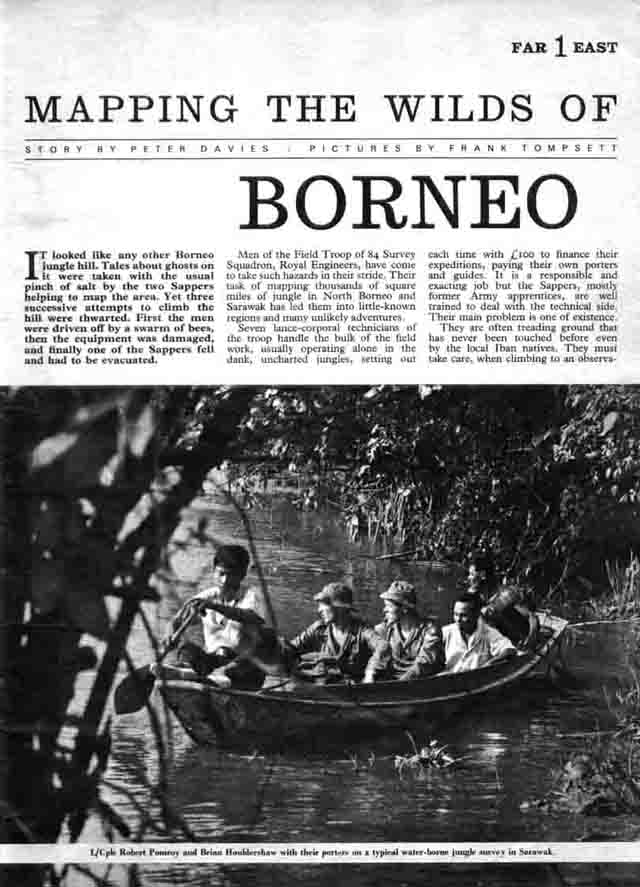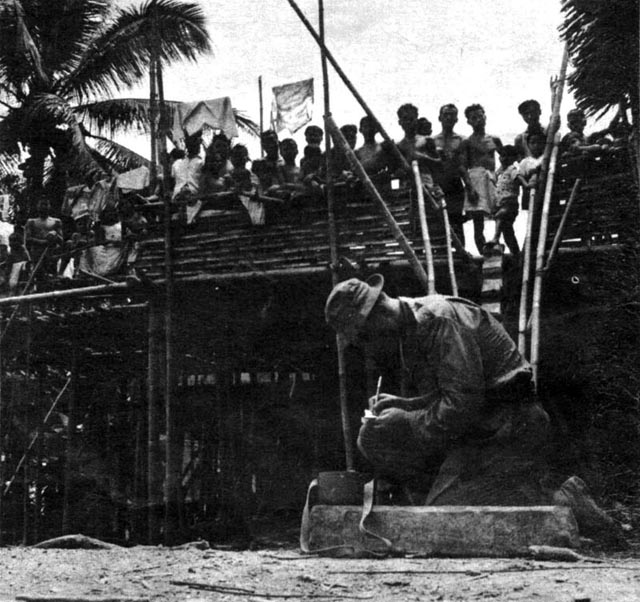
Soldier Magazine December 1963
This article relates
to 1 Topo Troop
in Sarawak in 1963
the first form is a direct scan and below that as recognised text with separate photographs.
© Crown Copyright /MOD.
Reproduced with the permission of the Controller of Her Majesty's
Stationery Office




Mapping the wilds of Borneo
Story by Peter Davies
Pictures by Frank Thompsett
It looked like any other Borneo jungle hill. Tales about ghosts on it were taken with the usual pinch of salt by the two Sappers helping to map the area. Yet three successive attempts to climb the hill were thwarted. First the men were driven off by a swarm of bees, then the equipment was damaged, and finally one of the Sappers fell and had to be evacuated.
Men of the Field Troop of 84 Survey Squadron, Royal Engineers, have come to take such hazards in their stride. Their task of mapping thousands of square miles of jungle in North Borneo and Sarawak has led them into little-known regions and many unlikely adventures.
Seven lance-corporal technicians of the troop handle the bulk of the field work, usually operating alone in the dank, uncharted jungles, setting out each time with £100 to finance their expeditions, paying their own porters and guides. It is a responsible and exacting job but the Sappers, mostly former Army apprentices, are well trained to deal with the technical side. Their main problem is one of existence.
They are often treading ground that has never been touched before even by the local Iban natives. They must take care, when climbing to an observation point, not to dislodge loose rock; they must watch for rotting trees that may fall at a touch, and all this in addition to the routine jungle precautions necessary to maintain health.
They must get to know the people, live with them and eat with them. Though the Sappers carry a small quantity of tinned food and take vitamin tablets, they share the natives' staple diet of rice, augmented by any local fish and game that can be caught.
The biggest enemy is the leech, especially the giant buffalo leech whose bites have a more telling effect as the Sappers' resistance is lowered by long spells in the jungle. When a leech bite starts to take a fortnight to heal it is time for a change of air.
Elephants are not usually a hazard, but there was one occasion in North Borneo when a survey party was charged by a mother elephant after her playful offspring had trotted over to make friends. The party dropped everything and scattered. No one was hurt but the equipment was ruined and the work held up.
The Sappers' task is part technical, part physical, part research. They work from a map compiled from aerial photographs showing rivers and villages. Physical details are added by working from the highest points in the area, calculating an unknown height from comparisons with two other heights previously determined. Setting up observation points involves chopping down 80ft trees to form a pyramid, and contacting the other points with a flashing light, heliograph or mirror. Sometimes, when the ground is unusually high, the key points are covered for long periods by cloud, and the surveyor may have to wait a month just to complete two hours' work.
But this is only one aspect of the task. The surveyor must also note the types of terrain, vegetation, swamps, water points, and name every village, jungle track and stream. This too has its complications as Malays and Dyaks use different place names. The district officer is accepted as the authority and the completed maps are sent to him for checking. But the whole process takes about two years and by this time a new district officer may have taken over who may have different ideas about some of the titles.
The young Sappers took a six weeks' Malayan language course before being sent into the jungle and several have augmented this by picking up the local dialects. This helps enormously in promoting good relations with the tribesmen, upon whom the Sappers depend for information and help. Much can also be learned from the porters. Each man learns his own job and gets on with it, and regular operations are performed with military precision under the Sapper lance-corporals' command.
The Field Troop, commanded by Captain G R Gathercole, is sharing the Sarawak Government's Land and Survey Department office in Kuching and co-operating closely with the Department in producing an up-to-date topographical record of the country.
The co-operation within this modern office block in the country's capital' is strangely echoed on a more personal, more rewarding level between lance-corporal and tribesman in the remote corners of this untamed yet friendly land.


Sharing the simple life of the people is part of the job. L/Cpls Jones and Gould squat in a room of a big longhouse at Segu.

Behind the big Segu longhouse, L/Cpl Jonathan Gould has a keen audience as he reads his altimeter.

L/Cpl Roger Jones leads his porters through
the typical Sarawak Jungle.